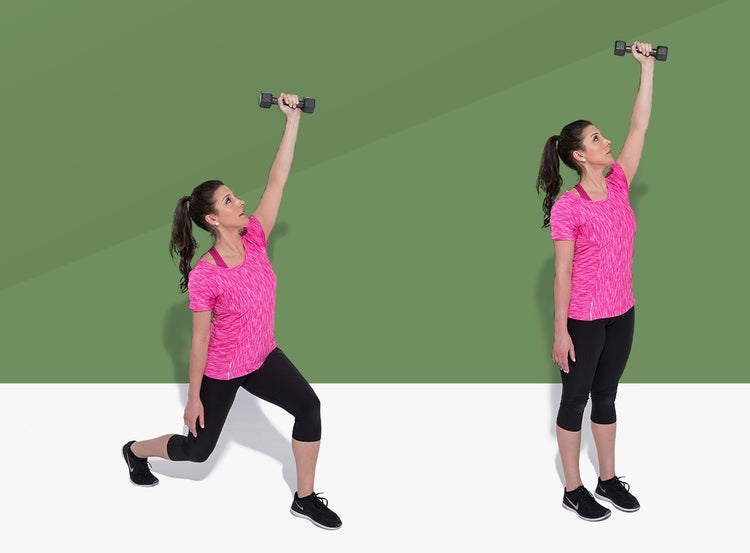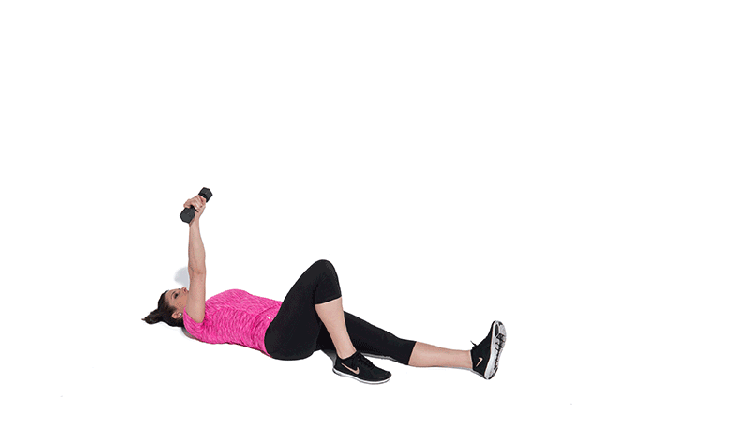Master This Move: Turkish Get-Up

The Turkish Get-Up (TGU) is a very complex but extremely rewarding move that challenges your stability and mobility at the same time during the entire move. It is also a drill that challenges you neurologically, as you have to navigate your body from the ground up and back down using a sub-maximal load. The TGU is the sum of multiple moves in all planes of motion, challenging every joint and muscle in the body, specifically the hips, shoulders, thoracic spine, quads and glutes.
Beginner

If you have never done a TGU, don’t try to perform the whole movement at once. Instead, break it down into two to three sections and slowly add on as you master each one.
When I first learned how to do a TGU, I kept performing one stage for weeks until I was totally comfortable with that particular section. And I did it with only my bodyweight, no load in my hand.
Try to relax into the movement and breathe easily as you move. Complete at least 60 to 80 repetitions on each side before you move to “advanced.”
Intermediate
Once you pass the beginner stage, it’s time for progression. You can continue to practice balance by placing a shoe on top of your fist, or start going through the move with a light dumbbell. However, you should keep the same speed. Don’t rush, and keep building your confidence.
Advanced
You’ve finally made it. You’ve learned the move and now it’s time to own it. This is the phase when you should get heavy with your weight. Keep your eyes on your load, move like a ninja and enjoy every step of this amazing drill.
Block one
Set-up, pick-up
Start on your back with one fist pointing to the ceiling, shoulder blades fully retracted (bring them toward your spine); one leg bent (foot planted on the floor), and the other leg fully straight and slightly open.
For loaded phases: Pick the weight up from the side and roll over to your back. Place the weight on your stomach and immediately press up so your loaded hand is directly above your shoulder.
Elbow, hand, hip lift
Initiate the move by driving your hand through to the ceiling and allowing your gaze to follow your hand, as you push down into the floor on the opposite side. This will bring you to your elbow. Here, rest for two seconds and check to make sure your spine is long.
From your elbow, move to your hand by maintaining a long spine. Don’t lose eye contact with your elevated hand. Then drive into your hand as your grounded foot lifts your hips so you create a “T” arm position.
Block two
By now, your bottom shoulder should be strong enough to handle a little bit more. Your hips should feel freer and your movement should be smoother. Let’s add two more moves.
Thread the needle, half kneeling
Bring your extended leg back so it’s directly behind your front heel. Re-check your position; you should see a little “L” (front foot, back knee and bottom hand). At this stage your top hand is still directly above the bottom hand. Next, take your supported hand off the ground and rotate your body toward you front knee.
Block three
In this phase we will finish the move.
Continue looking at the weight in your elevated hand as you drive your hand toward the ceiling by pushing the floor down and standing up.
This is half of the move. At this stage, you have two options:
- Lie down and practice these three blocks again.
- Return to your starting position by reversing the move.
Turkish Get-Up

- Lie on the floor with your right leg straight in front of you and your left knee bent, foot planted on the floor.
- Hold a dumbbell in your left hand. Press the weight straight above your left shoulder, making sure to keep your wrist and elbow completely straight. Extend your right arm next to you. This is the starting position.
- In one smooth movement, come up to your right elbow and then right hand. Punch upward with the weight and forcefully press your right hand into the floor so that your torso rises up and your weight shifts onto your right hand. Your right leg should remain straight. Keep your eyes on the weight the entire time.
- Without allowing your hand to leave the floor, rotate your right hand so that your fingertips are pointing at a 45-degree angle away from your body. Then, press away from the floor with your right hand to rise to a standing position, keeping your right leg and torso stiff as a board and your eyes on the weight.
- Reverse these steps to return to the starting position.
Common mistakes
A lot can be done during this move, so make sure you move slowly and controlled. But these are the most common concerns:
- Doing too much too soon. Take your time before you move to the next step. Don’t rush; get it right. Start with body weight.
- Losing hand-eye contact. Keep your gaze on the weight at all times.
- Softening your elbow. Your loaded/extended elbow should remain fully straight to protect your shoulder. Lock it in and throw the key out.
- Losing your grip. You should only be able to see your first knuckle. If you see all of them, it’s a sign of a bent wrist. Again, not good under the load.
The Turkish Get-Up, with or without the load, is a tremendously beneficial move which can be easily translated in day-to-day life. What is even more impressive is that it challenges us neurologically, mechanically and metabolically. A TGU can be used across a diversity of themes from movement preparation, activation and strength, to metabolic conditioning.
Photo credit: Tom Casey, box24studio.com
Looking for a workout that incorporates the Turkish Get-Up? Try this holiday express workout. Find more workouts on 24Go, or try a Group X class at 24 Hour Fitness.